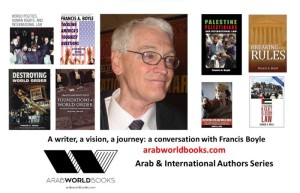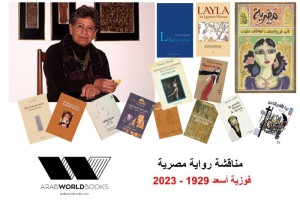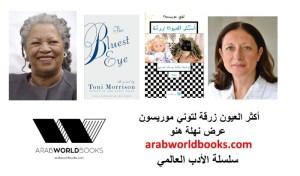Nawwat Al-Karm (Al-Karm Gales), Nagwa Shaaban,
Cairo: Mirette, 2002. pp295
Reviewed by Amina Elbendary
Nagwa Shaaban's second novel, Nawwat Al- Karm, boasts a whole cast of "others", including women, children, sailors, peasants, craftsmen, artisans, translators, merchants, pirates, belly-dancers, prostitutes, Muslims, Copts, Jews, religious fundamentalists, Sufis, pagans, magicians, healers, heterosexuals, homosexuals, transvestites, Egyptians, Ottomans, Mamluks, Bedouin, Sudanese, Moroccans and Greeks. Welcome to cosmopolitan, multi- ethnic sixteenth-century Damietta. Or, rather, welcome to contemporary Egypt as Nagwa Shaaban would like it to be.
That history is always written with an eye on the present is evident throughout this novel. Having read through its 300 or so pages, one takes a deep breath and reflects on Shaaban's starting point, which, in common with much in Arab intellectual life over the past century or so, was to answer the question of how we got to where we are today, or, more straightforwardly, "what went wrong?" To answer this question, Shaaban turns to history, integrating considerable amounts of historical research into her novel. But Shaaban, like the reader, gets a little lost, producing what is at best a hazy image of what life was like then, and what it is like now.
Nevertheless, Shaaban's novel is a contribution to what has been a growing genre over recent years -- the Arab historical novel. Women have favoured this form in particular, with the last decade having seen major historical novels from Radwa Ashour (The Granada Trilogy), Salwa Bakr (Al-Bashmuri) and perhaps Ahdaf Soueif (A Map of Love), though the latter author's work is written in English and therefore perhaps does not figure as Arab in quite the same way. Literary critics have also recently been concerned to deconstruct history, examining the differences between history and literature, and this is where Nagwa Shaaban enters with her densely packed novel Nawwat Al-Karm, which blends historical with literary writing.
In her novel, Shaaban attempts to bring the marginalised in from the margins to the centre, making determined efforts to consider the lives of ordinary people, as well as women, pagans, magicians, lunatics, heretics, Sufis and rebels, who have all too often been left out of official and orthodox historiography. Hers, then, is an attempt to write Egyptians back into Egyptian history, and so the protagonists of her novel are either women, such as Layl the kahk maker and her sister Sananiya, or colourful and unusual figures, such as the merchant El-Matrawi, El-Turguman (the Translator), El-Khazzaf (the Pottery Maker) and Amounette, a Coptic healer. Intricately structured, the novel begins in sixteenth- century Damietta but moves, sometimes quite abruptly, through time and place, with El- Turguman's twentieth-century granddaughter discovering some of his papers and herself retelling parts of the story that the novelist tells elsewhere.
However, this dimension of the novel, the internal dialogue between a contemporary character and her historical ancestors, is insufficiently developed, and it seems to have been introduced quite haphazardly. Also not sufficiently developed is the author's attempt to introduce multiple voices into the narrative. For while Shaaban is aware that these voices belong to characters from various cultural, class and ethnic backgrounds, she has not given them their own distinctive language. Spoken Coptic, for example, is mentioned in the novel as a language that has all but died out and one that only foreigners are interested in recording, but this thread in the novel, like many others, is left dangling or untied. While much that is in the novel is good, one feels that Shaaban hit on something at the outset and then got lost while trying to branch out: the author has simply tried to do too much, and, as a result, the reader becomes fatigued by the detail.
Such reservations aside, Shaaban's main focus is the multiplicity of human experience in sixteenth-century Damietta, and here she has been successful. Presumably this location and period were chosen because the sixteenth century was a watershed in Egyptian history, witnessing the downfall of the independent Mamluk regime and Egypt's incorporation into the Ottoman Empire. And Damietta would have been a dynamic port-city at that time, having access to both the Mediterranean Sea and the Nile, and therefore being open to multiple cultural experiences. By choosing this particular historical juncture, Shaaban seems to have subscribed to the traditional view that the Ottoman period was a kind of "Dark Age" in Arab history and the Ottoman conquest of Egypt the beginning of Arab downfall. One of the novel's characters, the mentally disturbed El-Mafzou', for example, is obsessed about having let Tuman Bay, Egypt's last Mamluk sultan, down, and not having been able to defend him from the invading Ottoman army.
Indeed, despite Shaaban's inclusivist historiography, her history is quite traditional. For, just as the Ottoman period is seen as the dark ages, so Sufism is looked down upon as backward and irrational. She describes, for example, one of the rituals practiced by members of the Sufi orders, the dosa, which involves the sheikh riding his horse over the prostrated bodies of his followers, many of whom are severely wounded as a result. She makes it plain that she disapproves of this. Also "traditional", though in a different way, is Shaaban's infatuation with the West as the source of modernisation, rationality and technology, an attitude reflected by several of her characters in the novel.
In fact, Shaaban peels layers of cultural experience off only to find further layers beneath. For this multiplicity, or plurality, of religions, customs and traditions, a plurality that is all too rarely celebrated these days, is seen as making up Egypt's identity. This is a multiplicity that seeks to reconnect with cultural roots and traditions, here embodied in the character of Amounette who connects Ancient Egyptian healing practices with Coptic theology. Having established strong connections with indigenous cultural roots, sixteenth- century Egypt was also open to foreign experience. Having moved to Rhodes, for example, Amounette learns Western medicine and science, incorporating this into her traditional healing practices.
It is also significant that the novel begins with news of the murder of Abdel-Gelil El- Matrawi, an influential merchant of foreign background, and ends with the deaths of Layl, El-Turguman, El-Mafzou' and Amounette, the protagonists of the novel, as well as with an explanation of El-Matrawi's death. For these characters die as Egypt and the world is changing around them, leaving little place either for them or for the kind of generous multiplicity that they represented. Should we draw conclusions about contemporary Egypt from this?
These characters had multiple cultural roots, and they were tolerant in accepting difference. El-Matrawi, for example, is of European origin, and, having been recruited as a member of a Sufi order, is sold as a slave and then adopted by a rich Damietta merchant. He rises within the town's society and becomes a respected member of the community, loved by the poor for his charity. But he also has another side to his personality, one that enjoys festivals and colourful local celebrations. With the rise of a kind of religious Puritanism towards the end of the novel, there is no longer any room for him, and he dies amid attempts to remove his name from the town's historical memory.
Similarly, El-Turguman, the translator, is fluent in several languages and stands up to tyranny and oppression. However, he is rewarded with repression and imprisonment. In fact, many of Shaaban's characters are rebels of some sort, particularly the female characters, who resist oppressive cultural codes. Characters such as Layl and her sister Sananya are daring in their expression of their sexual identities, for example, and Layl, the kahk maker, is an independent working woman who is the breadwinner for her family and who marries late.
Just as the characters of the novel exist on shifting borders of nationality, sexuality, religion and politics, so too does the novel's action. Damietta is both the starting point and the continuing reference of the narrative, but, aside from this already provincial location, the action migrates to Mediterranean pirate ships, distant oases in the Western Desert, the island of Rhodes and the Sudan -- in other words almost anywhere but to Cairo, the traditional centre of political and intellectual power.
In Nawwat Al-Karm, then, Nagwa Shaaban has shown herself to be conscious of her role as historian. In her novel, El-Turguman's granddaughter attempts to find a chemical formula that will make her grandfather's secret writing visible, this idea being echoed in Shaaban's own writing practice. For Shaaban, too, is interested in what happens between the lines of the official histories, rewriting Egyptian history in an attempt to write a more tolerant, more cosmopolitan, more inclusive Egyptian future. For, she seems to be arguing, things really went wrong when sixteenth-century cosmopolitanism and openness were lost.




